I like lore. Here I post some of the things I find interesting. I also make videos sometimes.
Don't wanna be here? Send us removal request.
Text
The Cars of Mario Kart World
Mario Kart World introduces a brand new open-world style to the Mario Kart series, and with it, an entire island jam-packed with details to explore. While others were focused on completing missions, finding medallions or jamming to the banger soundtrack, another detail caught my attention: The many cars, trucks and other vehicles seen all over the island.
Together with @seandwalsh, we have catalogued every type of vehicle that can be found in this game, and discovered there seems to be a surprising amount of thought over which brands each vehicle belongs to. So here's our breakdown of what the biggest car manufacturers in Mario Kart World are!
Dash
The biggest car brand in Mario Kart World seems to be Dash, represented by a mushroom emblem. What could be their main office can be seen in Crown City, plastered with advertisements and their logo all around. Their slogan is "Accelerate the fun". They appear to sell popular cars for regular use, and are responsible for most cars around the island, including taxis and sheriff cars.
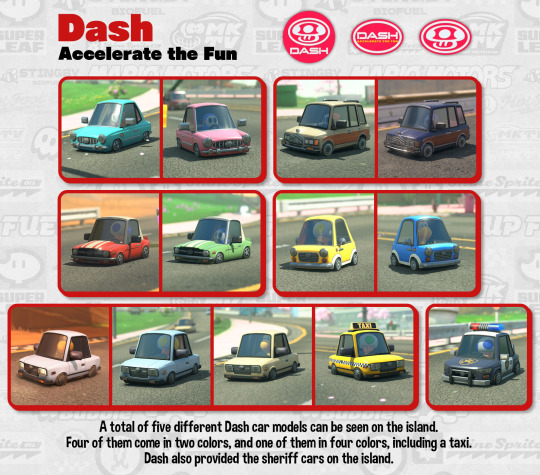
Fire Flower
Fire Flower is another brand of cars for popular use found in Mario Kart World. Their emblem is a square-ish Fire Flower and their slogan, according to a sticker, is "Bloom outdoors". This fits perfectly with the types of cars that carry their emblem, those being outdoors cars such as minivans, RVs and off-road cars. Amazing attention to detail.
Fire Flower also provided the new Mario Kart Television vans.
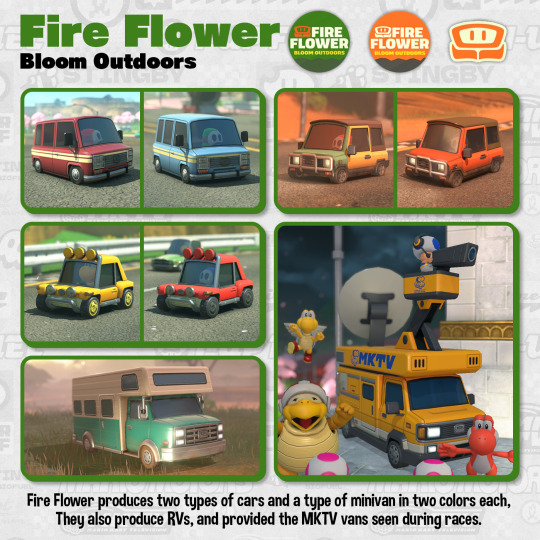
Super Leaf
Leaving the realm of cars, Super Leaf seems to be the main seller of large vehicles, and their emblem is, adequately, a Super Leaf. They are responsible for the cargo trucks, ramp trucks and tour buses that provide service around the island. The large drivable cargo trucks also appear to be modified versions of this company's trucks.
Interestingly, they make the box trucks that run around dropping Dash Mushrooms on the road. These trucks also have Toad Manufacturing branding on them (the company that runs Toad’s Factory), suggesting that they collaborated with them (or maybe modified Super Leaf trucks).
They also have a smaller mini truck model for regular use.
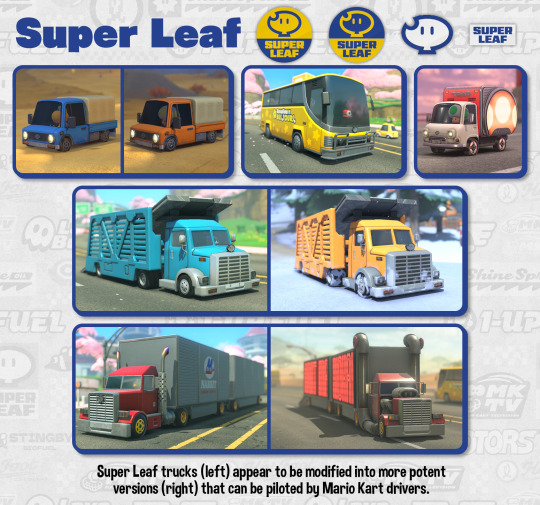
Banana
The Banana brand might only have a single model of trucks found in Mario Kart World, which bears this company's banana emblem on them, but it's clear that thought was still put in this Donkey Kong-owned company. Their trucks are seen carrying barrel cannons and surfboard ramps around roads. Fitting, for the Kongs.
As a bonus, I have a small theory about this company. Taking the fact that this is a Kong company and that their trucks are used to carry surfboard ramps around, it makes me think of one specific mechanic Kong with a love of surfing…. Funky has been involved in making barrel cannons before, after all.
Nothing is confirmed, but this is fun headcanon to have.

Spiny
The last brand seen on vehicles around the island is called Spiny, and they are branded with a Spiny Shell emblem. Only one model of truck carries this emblem, a purple pickup truck with orange flames. Given the name, and how their trucks are the only ones that carry enemies, it's possible this company is owned by Bowser or Bowser's Minions.
These trucks have been seen carrying Bomber Bill cannons, Hammer Bros., Spikes and other minions, (and vending machines, apparently). A fun little detail is that, unlike other cars that have Toads, Koopa Troopas and Shy Guys driving them around, Spiny trucks have only Koopa Troopas, the most iconic forces in Bowser's Minions.
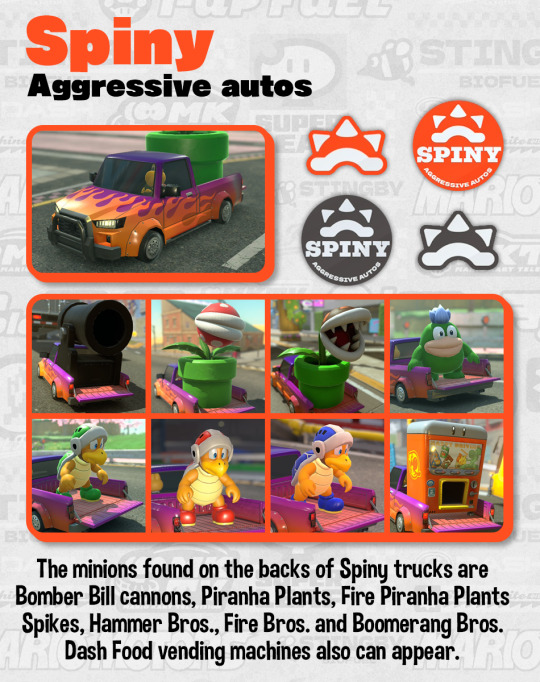
Rosalina Automobile
A Rosalina Automobile (or Automobiles, pick one, Nintendo!) building can be found in Crown City, along with other advertisements and stickers around the island, but no cars seem to bear their star-shaped emblem. For a game with so much attention to detail, it seems odd to have a car brand with no cars. Maybe they haven't opened yet? Or maybe they're actually a rental service?

Other vehicles
Lastly, a few other vehicles don't seem to carry any car brands, making it difficult to guess which company made them.
One of them is a toy-esque car with Toad Manufacturing branding that races around dropping items on the road. Unlike the Mushroom truck, this one has no apparent emblem on it. Since it looks much more cartoony, and resembles the design of Toad's Factory, it is perhaps an entirely original creation by them.
The other three of those vehicles are all the same model of pickup truck, seen carrying around pipes and lifts. They belong to a company called Hammer Bros. Repair Services, but it is unclear who provided the vehicles themselves. The truck's grill and headlights form the shape of a spanner, so perhaps they were customized by this company.
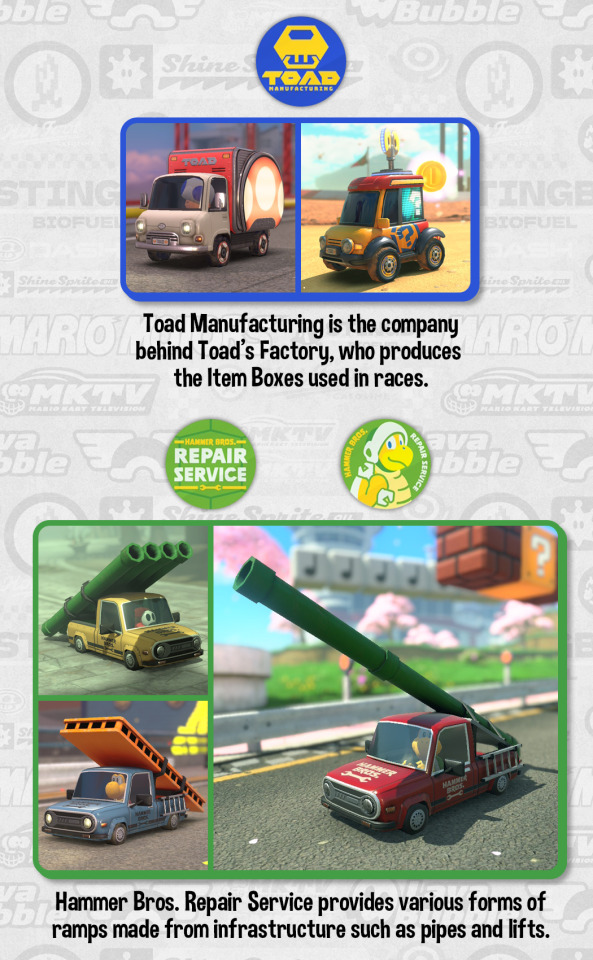
And that's all @seandwalsh and I could gather from the vehicles seen in Mario Kart World!
Thank you for reading through my ramblings, and I hope you can now appreciate this miniscule detail in an already amazing game. If I find anything else about those vehicles, I'll make sure to make a follow up post in the future!
242 notes
·
View notes
Text
The Stuffed Bellbloom and the Mystery of Sparklium: A Pikmin Theory
Hey! Pikmin (HP) is considered a black sheep in the Pikmin series, standing out by offering a much different style of gameplay compared to other entries. Because of this, HP is often overlooked and disregarded when compared to the more streamlined, numerical entries. Despite this treatment, the influence of HP on the series cannot be denied, with one of the most prominent examples being the presence of Sparklium in Pikmin 4, an energy source first introduced in HP. Given the clear story relevance that HP has on the rest of the series, it may be worth analyzing other aspects of the game to see if a greater understanding of the wider narrative can be gleaned.
In the second level of Snowfall Field, the seventh sector of the game, Olimar encounters an enemy called a Stuffed Bellbloom.

This enemy appears to be a bulbous yellow sphere, with four tiny legs supporting its massive frame. On the front of its body are what appear to be porous holes, potentially its eyes. It has a large tail on its rear, resembling the opening of a bag, fitting given it releases Sparklium Seeds from this “opening” during the fight. Upon being defeated, it drops the Fond-O-Sphere, recognizable as a marble with a heart in it. While it may be easy to overlook a strange, one-off enemy in a Pikmin game, there may be more to this creature than meets the eye. Its general appearance heavily calls to mind a more common Pikmin enemy, the Yellow Wollyhop.

While these aesthetic similarities alone are rather striking, Young Yellow Wollyhops, the juvenile form of a Yellow Wollyhop, are frequently encountered in this area, with two being located right before the chamber of the Stuffed Bellbloom, suggesting a relationship between these juveniles and the Bellbloom.

Furthermore, it can be demonstrated via gameplay footage that the Yellow Wollyhop and the Stuffed Bellbloom have very similar mannerisms and attacks; they both hop in the air before crashing down on any Pikmin below them, and upon death they turn over on their side, defeated.
Given the aesthetic similarities as well as the direct connection to Young Yellow Wollyhops, it’s a reasonable conclusion that the Stuffed Bellbloom is, somehow, a Yellow Wollyhop. However, that merely opens the door for more questions; how does a Yellow Wollyhop change so drastically to become the alien-like Stuffed Bellbloom we see in HP?
The plot of HP (and to a lesser extent, Pikmin 4) revolves around collecting the previously mentioned Sparklium, or Sparkling Energy (キラキラエネルギー), a strange type of energy that is used as fuel for space-faring vessels, such as the S.S. Dolphin II and the S.S. Shepherd. This strange fuel is acquired in various ways, including by siphoning it from a wide variety of strange items.
Indeed, Sparklium is found in many objects, from household items like a Gameboy Advance to even living things such as plants - seeds full of Sparklium, also called Sparkle Seeds (キラの実), are found in abundance in HP. The Fond-O-Sphere that the Stuffed Bellbloom drops also contains Sparklium energy. Given that Sparklium can affect flora, as demonstrated by Sparklium Seeds, is it also possible that it can affect fauna?
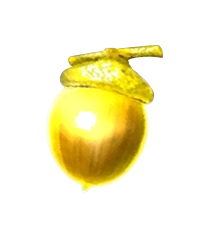
The final boss of HP is the Berserk Leech Hydroe, which was originally just the Leech Hydroe until an important part of Olimar’s Ship, the Sparklium Converter, was lodged in its head. Olimar has this to say about it in the ingame logbook:
Normally, this is a harmless species of plant life. We only found out later that it grew vicious because the Sparklium Converter fell from the ship during our crash landing, falling onto the Leech Hydroe as it slumbered. The influx of energy sent its parasitic urges out of control.
Olimar - Hey! Pikmin
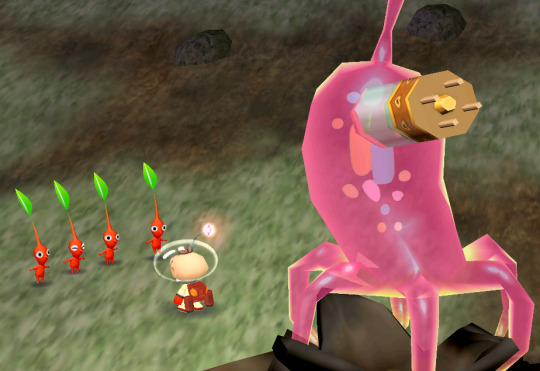

From here, we learn exactly what caused the Leech Hydroe to become violent and change appearance; the influx of energy - that is, the Sparklium from the Converter - modified its biology, sending its “parasitic urges out of control.” Because of this, we can determine that Sparklium can affect non plant-life as well. With this in mind, it is not out of the realm of possibility that the Stuffed Bellbloom is a Yellow Wollyhop that has been “affected” by Sparklium to a degree that its physical makeup has been substantially changed from that of a typical Yellow Wollyhop.
However, that merely opens the door to another question: If Sparklium can affect creatures in this way, what is Sparklium?
The Geiger Counter ship part that can be found in both Pikmin 1 and Pikmin 4 could be particularly revelatory here. As Olimar says,
This noisy gauge is always letting off spontaneous clicks and buzzes. It can be kind of annoying.
Olimar - Pikmin
Naturally, the implication here is that the Geiger Counter is commonly surrounded by radiation. This insinuates that the surface of PNF-404 is irradiated, which suggests a possibility: Sparklium may simply be radiation.
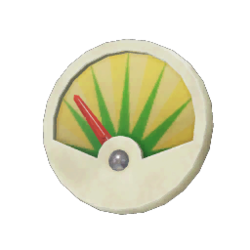
This interpretation of Sparklium is also supported by an in-universe note from Olimar in Pikmin 4, detailing treasure. It is accompanied by the following image:

Interestingly, per Pikipedia, the fan-run Pikmin Wiki, the above image features the following sentences written in the in-universe alphabet first used in Pikmin 3:
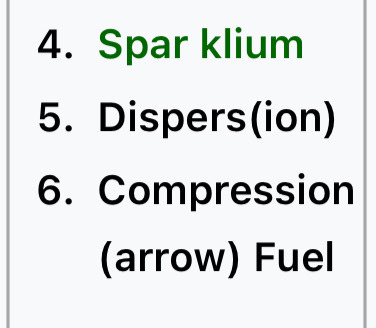
The references to dispersion and compression in this context are interesting; compression refers to the turning of raw Sparklium into fuel - probably by a Sparklium Converter, as seen in Olimar's S.S. Dolphin II in HP. Dispersion, however, could refer to the dispersion of radioactive ions, resulting in objects and creatures being influenced by radiation energy. This seems even more likely with the separation of "ion" from the rest of the term in dispersion.
This would explain several things: why Sparklium can be found within objects as well as living things such as plants and animals, why it can be used as an energy source, and, pertinent to the original purpose of the article, why it had the effect it did on the Stuffed Bellbloom.
A Yellow Wollyhop hoarded items full of Sparklium - or, more blatantly, radiation - which severely irradiated its body and caused its molecular makeup to begin drastically changing from its previous form.
In conclusion, while this isn’t necessarily conclusive on the topic of what Sparklium is, it strongly supports the notion that Sparklium is radiation energy.
12 notes
·
View notes
Text
I'm making this its own post because it's getting LONG but I might have found The Place


The trees and slope are close with the acknowledgement that these were in canon taken 100 years apart but wait there's more


This angle is harder to get but you can see there is a hard dirt clearing, and it also forms small, shallow puddles when it rains

Not only that but it's in a very interesting location, extremely close to major locations but is itself fairly remote, and just far enough from the road to be hard to see between the mist and the trees

Which is directly south of

Which just so happens to be the only place in game where we see fog with white motes

AND ALSO has fireflies, just as a bonus


Unfortunately for us/fortunately for nintendo et al the mist and lighting in the cutscene make it extremely difficult to see the surroundings. Any inconsistencies can also be explained away by the intervening 100 years and the fact that it's technically in a different universe and most of the kingdom was destroyed.

What's that wall(?) doing there?


The color's off (lighting?) but that rock looks more like the knobby, cracked Eldin rocks just a little way up the slope than the gray, smooth rock in the rest of Hyrule


Like the gray rock face on the north side of the clearing
At the very least they probably took an in game location and tweaked it as opposed to creating a whole new location from nothing just for one tiny cutscene. And we already know they will plausible deniability the absolute living crap out of any detail about Astor instead of having to gasp confirm any detail about his backstory
49 notes
·
View notes
Text
Where does Astor come from?
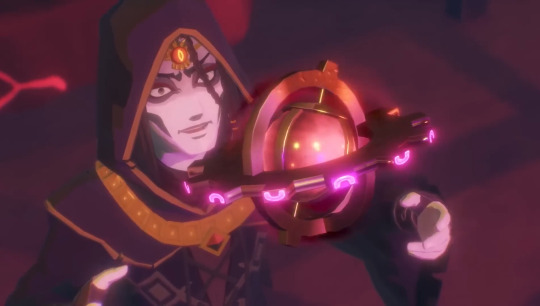
Astor is one of the main antagonists of Hyrule Warriors: Age of Calamity who lived in the era 100 years prior to The Legend of Zelda: Breath of the Wild. He is a follower of Calamity Ganon and works with the Yiga Clan to ensure his revival. He uses Harbinger Ganon, which is the miniature Guardian Terrako who had been corrupted by Ganon's Malice from the future, to see visions of the future.
In Age of Calamity, Astor is given little backstory or context. He is stated in his in-game profile to be from a certain small village in Hyrule and wears robes that are emblazoned with the symbol of the Gerudo, meaning he is likely one of the few in Hyrule who is aware of Calamity Ganon's origins as the Gerudo King Ganondorf, alongside the Gerudo themselves and possibly the Yiga Clan. Furthermore, in the DLC Guardian of Remembrance, it is revealed that Astor was part of a group of people who worshiped Ganon and wore similar robes to him. When they found Harbinger Ganon, all of them were killed except for Astor, which he interpreted as being chosen by Ganon.

This is more or less all that is given in Age of Calamity. There has been an idea floating around that Astor is also the fortune-teller who informed the royal family of the Sheikah technology buried all around Hyrule that needed to be dug up in order to oppose Calamity Ganon's revival. The idea being that the fortune-teller lured the royal family into a trap, as Ganon would go on to possess the Sheikah's technology and use it to destroy most of the Kingdom of Hyrule.
While Astor can see the future in Age of Calamity, this ability is entirely predicated on Harbinger Ganon. It consequently only exists because Terrako from the main timeline wherein Breath of the Wild takes place traveled to the past to avert the revival of Calamity Ganon. Some of Ganon's Malice followed it and possessed Terrako of the past in the new timeline, after the royal family had already begun to dug up the Sheikah's technology. Astor could thus not have seen the future in the main timeline and by the time he gains the ability to do so in Age of Calamity, that particular prophecy has already been spoken out.
The voice memories included in Zelda Notes with the Nintendo Switch 2 versions of Breath of the Wild and Tears of the Kingdom might reveal where Astor originated from. In memory #95, Den of Madness, Zelda tells that cultists who worship the Demon King once lived in Hyrule. They consider the giant fossil in the Bottomless Swamp an idol worthy of their worship.
"I have heard that the giant fossil in Bottomless Swamp was once worshipped by cultists who considered it the Demon King from ancient times."
This could refer to the group Astor is a part of or the Yiga Clan, who similarly follow Calamity Ganon. Two other memories may identify the village Astor is from, specifically memory #90, The Shadow People, from Breath of the Wild and memory #89, The Lost Hamlet, from Tears of the Kingdom.
"The Shadow Hamlet is a secluded village where people prefer to live somewhat disconnected from the rest of society. Many in Hyrule do not even know this place exists. I at least, knew the name, but I had no idea it would be like this. I came to warn the people here about the Calamity, but they turned me away..." "No one actually knows what happened here at the Shadow Hamlet during the Calamity. They were a very isolated village, and they liked it that way. They even turned me away when I came to warn them about the Calamity. I wonder if this place would be more than ruins if I had tried harder to get them to listen..."

This is about the Shadow Hamlet Ruins, found on the eastern foothills of Death Mountain in the game. It is a secluded place with only a few wooden houses, which apparently housed a reclusive people that did not wish to leave their home when the Calamity threatened Hyrule 100 years ago. It seems plausible that Astor and his fellow Ganon worshipers may have lived here, eagerly awaiting the Calamity, and likely perished during the event in the main timeline. Given that they worshiped Ganon, they likely secluded themselves from the rest of Hyrule, who consider Ganon evil.
97 notes
·
View notes
Text
On the origins of Shez
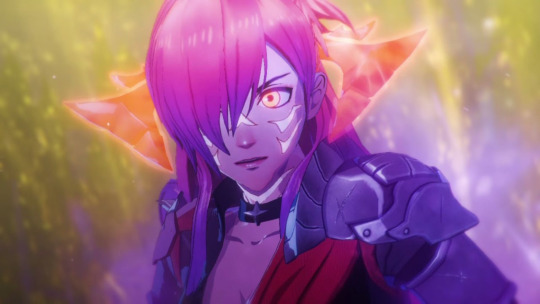
Shez is the protagonist of Fire Emblem Warriors: Three Hopes and a mercenary who helps shape the war that erupts across the continent Fódlan during the events of the game. They are not in the original game, Fire Emblem: Three Houses, likely because their survival in a battle against Byleth marks the point where the timeline of Fódlan diverges to lead either into Three Houses or Three Hopes.
And while they appear to be a simple mercenary at first, their origins are shrouded in some mystery. They share their body with a being known as Arval, who can grant them great power. So what actually are the origins of Shez and Arval?
Shez’s life before becoming a mercenary
Shez is thought to be in their late teens, as they are said to be around the same age as the students attending the Officer’s Academy of Garreg Mach Monastery by Archbishop Rhea. It is unknown who their biological parents are, as they were raised by a woman in a secluded mountain village. The village was situated in the Ordelia territory in the far south of the Leicester Alliance.

(Credit to @cartographers-office for removing the names from the Fódlan map used in the above picture)
In various Support Conversations, more details are given about this time of their life. To Yuri, Shez tells that their adoptive mom took them in when they were abandoned. Most of their Support Conversations with Ashe are dedicated to their mom. It is said she was a smart woman who knew about most things, including magic. She also taught Shez arithmetic, to read and to navigate using maps, things that are noted that only nobles are taught in Fódlan. Finally, to Claude Shez explains that their mom at one point fell ill and died. They were then chased out of their village and they fell in with a mercenary group when they ran out of money. Shez started out by doing their laundry and eventually worked up to become a fighter, which is they are found at the start of Three Hopes.
On Epimenides and Arval

The backstory of Shez raises some questions, but is mostly just vague on its own. However, Shez’s body also houses the being known as Arval. They awaken when Byleth is about to kill Shez and grants them power that allows them to survive the encounter. The presence of Arval, who does not have any memories either, raises many more questions about where Shez originally comes from. Arval’s origins are explained more in Chapter 15 of Three Hopes, The Hour of Vengeance, and the Paralogue Cycles of Nostalgia.
In the former, a man called Epimenides who looks identical to Arval, talks with Arval. He explains that his race wavers at the brink of extinction and that he seeks to reclaim the world for his people. He created Arval and seems to have sought to place his own soul within Arval, but this is a dangerous technique that can lead to irreparable consequences if an essence is wrongly transplanted. The initialization of Arval’s consciousness faced an unforeseen accident, but proved to be useful to Epimenides in another unspecified way, which would allow Arval to become Epimenides.
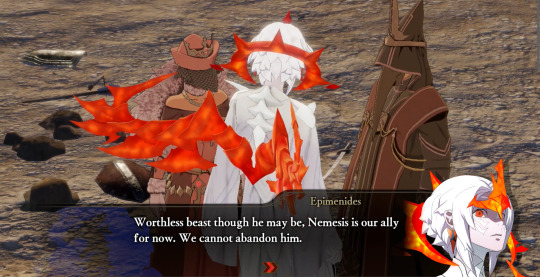
The identity of Epimenides is made more clear in Cycles of Nostalgia and the introductory cutscene of Three Hopes. There, he is seen fighting in the War of Heroes that transpired more than a thousand years before the events of the main games. He fights against the forces of the Adrestian Empire and the Four Saints led by Saint Seiros leading several dark mages in battle, aiding the forces of the Liberation King Nemesis. He also references Thales, the leader of the Agarthans or Those Who Slither in the Dark. This makes it clear that Epimenides is an Agarthan. This is further made clear by the presence of ruins that bring to mind Shambhala, the underground home of the Agarthans, in the void of Zahras where Epimenides and Arval reside.

The introduction cutscene of Three Hopes then shows how Epimenides met his end and how Arval failed to initialize. During a battle of the War of Heroes, Epimenides led some Agarthan mages into battle and caught the attention of Saint Seiros. She transformed into her dragon form, the Immaculate One, and killed the Agarthans, including Epimenides. Before that, water is seen rushing and some markings that indicate this is inside Shambhala. This lines up with how Arval’s initialization is described.
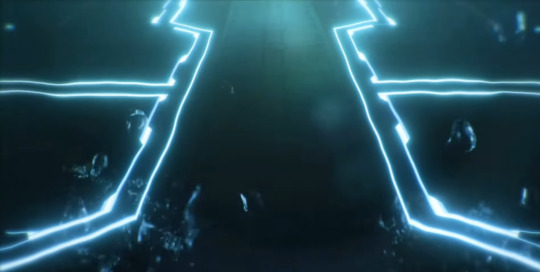
“When my consciousness first initialized, I was nothing. I remember the sound of water… Of bubbles… The sound of a massive object slowly lurching along… I thought the noise would continue for eternity. But then…a change. Something gave way. The water began rushing rapidly. Pale shadows closed in around me. Amidst deafening sounds, I walked desperately in search of light.”
What are the Agarthans?
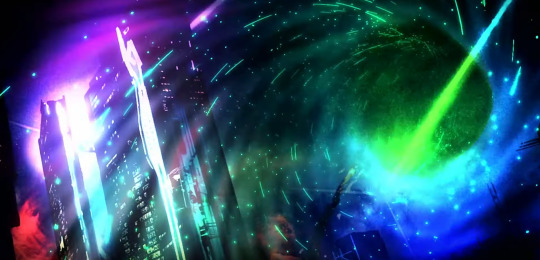
The query as to Shez’s origins and their relation with Arval and Epimenides thus ties into the Agarthans. It also begs the question as to what they are. They appear to be very long-lived, as Thales was around during the War of Heroes and is still the Agarthan leader in the present day. They are also capable of shapeshifting and do not want the secrets of their bodies to be revealed, as Thales says in Chapter 10 of Three Houses.
“If you were to die, then the mystery of our bodies would be revealed. Preventing that was my only aim.” -Thales in Chapter 10 of Three Houses, Where the Goddess Dwells
In Chapter 22 of Three Houses’s Verdant Wind route, Fodlan’s New Dawn, the history of the Agarthans is explained. They were the original humans who inhabited Fódlan and were a technologically advanced civilization. At some point they waged war against Sothis and her children, the draconic Nabateans. In that war, Fódlan was all but destroyed and the Agarthans retreated underground to Shambhala to bide their time. Sothis would eventually use her power to restore Fódlan, although this took an extremely long amount of time.
The Agarthans are thus human and also consider themselves as such. In the Romance of the World’s Perdition, a book found in the Shadow Library in Abyss of Garreg Mach Monastery, they are described as “the children of men”. The book was likely written by the Agarthans and tells of the war against Sothis and the Nabateans from their perspective.
But that begs the question as to how they are so long-lived and have abilities like shapeshifting. A hint might be found in the concept art of the Agarthan Solon, which reveals something interesting about his gloves and eyes.

“He is fitted with a prosthetic eye made with Agarthan technology that can store magical power and knowledge. His right eye does not blink because his eyelids are fixed.”

“These gloves are sewn directly onto the wrist. They have a smooth texture.”
These pieces of concept art, which are reflective of Solon’s final design, reveal that his body is integrated with advanced Agarthan technology. His gloves are sewn directly into his arms and his unblinking eye allows him to store knowledge and magical power. Furthermore, in Chapter 10 of Three Houses, Where the Goddess Dwells, Solon pulls an object from the chest of fellow Agarthan Kronya. He shatters it and uses it as fuel for the Forbidden Spell of Zahras. The object is hard to make out, but appears to be metallic in nature.
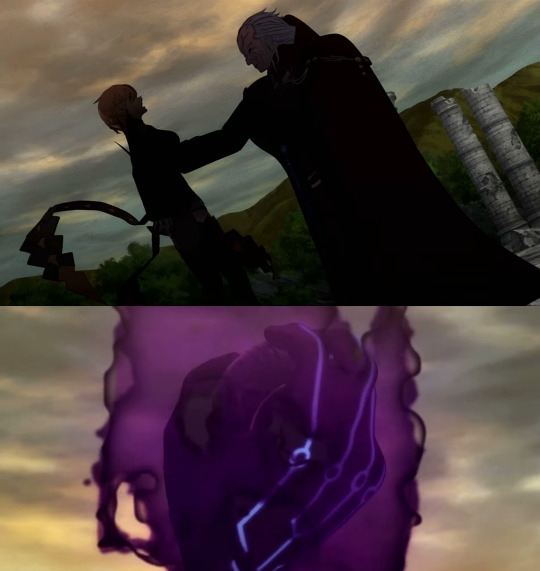
The Agarthans are thus most likely humans who used their advanced technology to cybernetically enhance themselves, giving them long lifespans and the ability to shapeshift. They do not want the humans of Fódlan, who they consider beasts, to discover this and so go to lengths to keep the contents of their bodies a secret. Furthermore, in Three Hopes, it is also implied that they sometimes switch out bodies when their current bodies give out. They talk about “this flesh” when they are wounded and how it has run its course, likely referring to this.
“I need to get this flesh underground…” -Solon in The Hour of Vengeance (Three Hopes) “So this flesh has run its course. No matter.” -Thales in The End of Tragedy (Three Hopes)
Attack of the clones: Arval and Shez
With all of this context, it becomes clear what Shez’s relation to Arval is and what their origins are. Epimenides was likely the one who invented the technique to rehouse souls, allowing the Agarthans to swap out their bodies. Arval was supposed to be a backup body for Epimenides, but things went awry when their consciousness was initialized. Everything was lost according to Epimenides, but then Arval proved useful in a different way.
It seems likely Shez was another backup body of some kind. Solon confirms in The Hour of Vengeance explicitly that Shez is from Shambhala and in Chapter 10 of the route Azure Gleam in Three Hopes, Fanaticism, the Agarthan Myson says the following to Shez.
“Why? Why do you wield the power of Epimenides? […] Tell me, where did you obtain it? Unless… His core!” -Myson in Fanaticism (Three Hopes)
It seems the core is what is transferred from body to body with the Agarthans and may have been the device that Solon pulls out of Kronya in Three Houses. The core of Epimenides was first housed in Arval and came to house their rudimentary consciousness as well after their initialization failed. It was then transferred to Shez, who was created in Shambhala. The streaming water that Arval and Epimenides reference is likely a liquid they were held in while in stasis, perhaps in one of the holding pods on the lower levels of Shambhala that are seen in Three Houses.
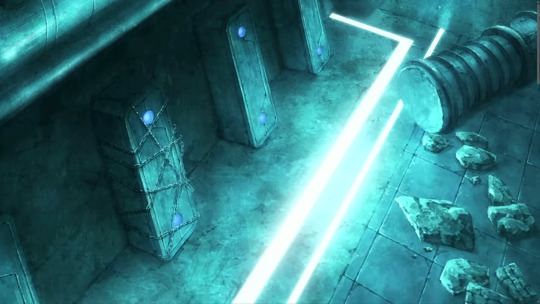
Shez was likely taken from Shambhala by the woman who would become their adoptive mother. She may have been an Agarthan, hence her great knowledge of many fields, who felt pity toward Shez and their destiny to become a vessel for Epimenides. The hamlet where Shez grew up is located not far from Shambhala after all, as its entrance sits on the other side of the Airmid River that borders the territory of Ordelia.

(Credit to @cartographers-office for removing the names from the Fódlan map used in the above picture)
17 notes
·
View notes
Text
Isn’t it weird how Pokemon Eggs aren’t actually eggs (like, irl eggs), and this info is relegated to two minor NPCs and is never brought up outside of that?



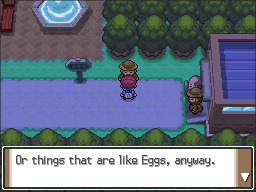
I feel like this is almost never brought up, so I imagine many just don’t know about it. We have eight different Pokemon families confirmed/implied to reproduce through non-Egg means (two of them, Rabsca and Blissey, even have non-Egg eggs), and we can put regular eggs on sandwiches and in curry. Meanwhile, according to this, Eggs– the white and green ones– are “cradles”-- and this has been the intent since the beginning! In a 1999 strategy guide for Gold and Silver, there was a section with an explanation of Eggs by Professor Elm, they’re called plant-based cradles! (unfortunately no scans of this exist online, and I’m going off a Japanese blog post about the book…)
The implications of this are weird. Where do Eggs come from actually? Why can almost any Pokemon produce them? I dunno! There’s a lot of discussion to be had about this! (Eggs aren’t exclusive to the Day Care, either– the Larvesta Egg in Black and White was found in the Relic Castle!)
98 notes
·
View notes
Text


In Luigi's Mansion for the Nintendo 3DS, Luigi gets a call from Professor E. Gadd from the future, in which he explains that he finished making Gooigi and needs past Luigi to test his experiment.
Interestingly, before E. Gadd appears during the call (top), a picture of the Dark Moon completion counter can be seen, which shows it half intact.
As this has only ever been the case while Luigi was in the process of collecting the Dark Moon in Luigi's Mansion: Dark Moon (particularly while he was in the Old Clockworks), this means E. Gadd worked on Gooigi in the middle of that game's plot, and never told "present-day Luigi" (the one the player is controlling in that game) about it. Instead, he chose to contact "past Luigi" (from Luigi's Mansion) for this, and only revealed Gooigi to Luigi in real-time in Luigi's Mansion 3.
Main Blog | Patreon | Twitter | Bluesky | Small Findings | Source
430 notes
·
View notes
Note
So I got two questions that I’m sure been asked before so sorry, but I’m just genuinely curious
Has there ever been an explanation or implication on who Bowser Jr. mom is, or where he came from?
Also what’s the relationship between the Koopalings and Bowser?
Officially, we don't know where Bowser Jr. came from or who his mother is. Shigeru Miyamoto once gave a tongue-in-cheek meta answer of "himself" when asked who Bowser Jr.'s mother was by Nintendo UK, but of course that doesn't apply in-universe, as he clarified in a separate interview released the same day:
"Bowser's only child is Bowser Jr., and we do not know who the mother is."
[Source: Shigeru Miyamoto, Producer of the Super Mario series, GameInformer, September 2015]
We at least know that his mother is not Princess Peach, as is confirmed at the end of Super Mario Sunshine.



My opinion is, simply, that Bowser Jr. does not have a mother. Bowser is completely obsessed with Princess Peach and he is single-minded in his pursuit of her. Being the emotionally immature tyrant we know he is, it's unlikely Bowser has ever been in a committed relationship with anyone, especially during games set in the period where Bowser Jr. would've been conceived.



So if Bowser Jr. doesn't have a mother, where did he come from? First we must understand where children in the Mario universe come from in general. As established in the Yoshi's Island series, newborn babies are taken from a place in the sky and delivered by Storks to their parents. As we learn in Super Mario RPG, parents like Raz and Raini can make wishes to the Stars for children. This may mean that the Stars are responsible for creating the babies that the Storks deliver.



However, as we learn in Paper Mario, the Stars do not grant the wishes of bad or selfish people like Bowser. This would prevent him from having a child of his own delivered.

"The Star Rod... ...is powerful beyond belief. It can grant any wish. For as long as we can remember, Bowser has been making wishes like, for instance... "I'd like to trounce Mario" or "I want Princess Peach to like me." Of course, Stars ignore such selfish wishes. As a result, his wishes were never granted."
[Source: Mamar, Star Spirit and guardian of the Star Rod, Paper Mario, February 2001]
When Bowser discovered that the Stars were out there granting wishes but that his weren't making the cut, he started to believe he should be the one who decides which wishes are granted.



"Bowser...that fiend... When he found out that we were ignoring his wishes, he came and stole the Star Rod so he could grant his own wishes. He seems content right now, mainly because he defeated you and captured the princess. Soon enough, though, I fear he will wish for more...and then terrible things will happen."
[Source: Skolar, Star Spirit and guardian of the Star Rod, Paper Mario, February 2001]
Here's where my personal headcanon comes into play. We know that when Bowser took the Star Rod, he used to to grant several selfish wishes for himself and his minions - to take revenge on the Star Spirits, to have enough power to defeat Mario, to create a flying castle beneath Peach's Castle, to create King Goomba, etc. Well perhaps he also used it to fulfil one more selfish wish - to have a son.
So, I believe that during Paper Mario, before Mario defeated Bowser and reclaimed the Star Rod, Bowser was finally able to wish for a son. With no partner for the Star Rod to pull genetic information from, it could only create said son based on Bowser's DNA, resulting in a baby that is essentially a clone of Bowser being delivered not too long afterwards. This explains why Bowser Jr. looks identical to Baby Bowser.
"King Bowser's son. A naughty brat who loves mischief. He resembles Bowser when he was younger."
[Source: Bowser Jr.'s character profile, Nintendo Kids Space, Nintendo Co., Ltd. website]
Bowser's ego fuels him. Bowser wants to rule the universe because he’s incredibly self-aggrandising and narcissistic. He was never told "no" for an answer. In theory, to Bowser, a son would be an extension of himself and a continuation of his legacy. Thematically speaking, the fact that Bowser Jr. looks identical to Baby Bowser and is also named Bowser is no coincidence. With this in mind, it's easy to see why the Stars would not deem him fit to be a father.
The funny thing is that (in this interpretation) Bowser may have actually found a love in his son that goes beyond his selfish nature. The Stars were wrong in this case, and Bowser learned how to care and provide for someone else through being a father in a way he never had before. As we've seen since Super Mario Sunshine, Bowser truly loves his son and wants him to be happy on his own terms. Bowser Jr. is not a vessel for Bowser to express his vision of the world through, he's his own person - and he's essentially given Kamek a second chance at raising the King of the Koopas right, as we see in stories such as Bowser Jr.'s Journey.
In fact, I would even argue there's evidence to suggest Bowser wanted to appear better for his son. Bowser has always been proud of his evilness, since he was a child, almost in an aesthetic sense. However, when it came to raising Bowser Jr., Bowser hid his villainy. In Super Mario Sunshine, Bowser attempted to justify his kidnappings of Princess Peach to Bowser Jr. by telling him that she was his mother and Mario had actually kidnapped her instead.

"Yeah, Papa told me all about it. He told me my Mama got kidnapped by a bad man named Mario! [...] So I came here to rescue her! [...] Papa told me everything. He said 'Mario's a bully, he never fights fair!' He said, 'Jr., you gotta try to outsmart Mario!' So I tried to get him sent to prison, but they didn't lock him up, and now he's here to steal Mama Peach again! You…You pest! Stop following us!"
[Source: Bowser Jr., Son of Bowser and Koopa Prince, Super Mario Sunshine, July 2002]
Bowser eventually felt guilt over this lie that spun out of control, confessing the truth to his son in a tender moment. in truth, Bowser Jr. already knew that Princess Peach wasn't his mother, and it seems he only went along with the plan to make his dad happy.




But why lie in the first place? Well as it turns out, Bowser Jr. has always wanted to be a hero:
"BWAHAHA! Did you really think I'd let my own son defeat me like that? I hope you had fun playing the hero, kiddo! Well, Junior always said he wanted to be a hero, so I gave him the opportunity."
[Source: Bowser, Father of Bowser Jr. and Koopa King, Mario Party: Island Tour, November 2013]
In fact, until the events of Bowser Jr.'s Journey, he still believed that his dad and the rest of Bowser's Minions were "the good guys". Bowser, despite the tough, villainous reputation he's worked so hard to upkeep for all these years, initially wanted to make his son believe he was good - to make his son proud of him.












As for the Koopalings, @thepipeplaza has done a post summarising all of the relevant information on them. In short, they're Bowser's minions and they lead his army under him. They see Bowser as their boss, and Bowser Jr. as their friend and future boss. Each Koopaling has their own opinions on both Bowser and Bowser Jr.
49 notes
·
View notes
Text
Coming soon...Do Inklings really die in water?
I'm laying the most controversial piece of Splatoon lore to rest once and for all: Yes. And it's more important than you think.

A feature-length, 1 hour and 20+ minute lore dump. Video out now for patrons, everyone else, see you Friday!
834 notes
·
View notes
Text
Which Titans were sunk by the Aegis?
500 years before the events of Xenoblade Chronicles 2, the Aegis War took place, the events of which are shown in Torna: The Golden Country, the DLC campaign for the game. It is said that during the war, the Aegis, a particularly powerful Blade, was responsible for sinking three Titans to beneath the Cloud Sea that Xenoblade Chronicles 2 is set on. Which Titans exactly however? Major spoilers for Xenoblade Chronicles 2 and Torna: The Golden Country follow.
The fact that three Titans were sunk by the Aegis is first made clear during a play seen in Chapter 4, made clear via a play that recounts the events of the Aegis War. There, the following is stated:
"Thus, they defeated the darkness. But at a terrible price! Three great continents sank below the sea of clouds forever."
The Aegis is also depicted as being responsible for banishing three monsters, likely stand-ins for the Titans that form the continents of Xenoblade Chronicles 2's world.
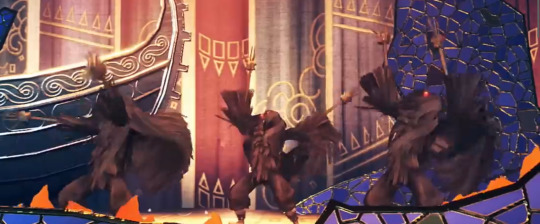
Visually, the Aegis in the play resembles Mythra.

This makes sense as she, along with her alter ego Pyra, is considered an Aegis, as her Core Crystal was found in Elysium where the Architect of the world resides. However, she is not the only Aegis, as her adversary during the Aegis War, Malos, came from the same place. Malos is also the one who gave himself the title of Aegis in the first place as seen in Torna: The Golden Country.
This shows that the play is playing fast and loose with the events of the Aegis War, as Malos was responsible for sinking one of the three Titans during the war. As explained during the introduction of Torna: The Golden Country:
"The 107th Indoline Preator, Rhadallis… had sent an armed expedition against the country of Coeia. Its capital, Omrantha, fell overnight… and sank beneath the clouds, along with the rest of the Titan. […] In fact, it had been the work of one Blade. The Aegis, a man known as Malos."
The play would have one believe Mythra was responsible for sinking all three continents, but this is not true. This could be chalked up to historical corruption, except that the writer of the play, Cole, was around during the war. Perhaps the truth is being obscured deliberately due to those in power during Xenoblade Chronicles 2 itself, but that topic falls outside the scope of this post.
Mythra herself is responsible for sinking the Titan Torna at the end of Torna: The Golden Country due to losing control of her powers and trying to take out Malos for good. This accounts for two of the Titans, but what about the third?
This is actually explained during Xenoblade Chronicles 2 instead of Torna: The Golden Country, though it was lost in translation. In Chapter 5, Malos says that he sunk Temperantia, which is a Titan that bears many scars:

ああ500年前俺とヒカリが沈めた国だ Yeah, the country me and Hikari [Mythra] sunk 500 years ago.
Temperantia is still floating on the Cloud Sea in the present, so it may be that what is considered "sunken" in the game is a bit loose. Perhaps the Titan did die during the Aegis War but it stayed afloat atop the Cloud Sea, instead of sinking to beneath it like Torna and presumably Coeia did. But those are the three Titans sunk in the war: Coeia, Torna and Temperantia.
3 notes
·
View notes
Text
The Nature of Twilight Magic and how it affects the World of Twilight Princess
In The Legend of Zelda: Twilight Princess, the Light World is overtaken by an alien magic known as twilight. Twilight magic, or shadow magic (影の魔力), first appears chronologically in the series when a group of magic wielders appeared in Hyrule, entering the ongoing conflict over the kingdom.
人々の中に、魔術に長けた者達が現れ強力な魔力によって聖地を治めようとしたしかし、神は我ら光の精霊を遣わしその者達の巨大なる魔力を 封じこませたのだそして、その魔力こそが黒き力・・・影の結晶石である
Among the people, people who were skilled in magic appeared and tried to rule the holy land with their powerful magical power. However, the Gods sent us spirits of light to seal away their enormous magical power. That Magical power is black power...the Crystal Stone of Shadow.
Lanayru (Twilight Princess) - Translated by Sidier
We learn that these invaders used a powerful magic known as the Fused Shadow, or, per the Japanese release, the Crystal Stone of Shadows (影の結晶石). In this conflict, they almost emerged the victors, until the Goddesses of Hyrule commanded the Light Spirits to put a stop to their plans. As a punishment for their crimes, these magic wielders were sealed away within the Twilight Realm via the Mirror of Twilight, and the Fused Shadow was sealed within three dungeons across Hyrule.

However, this doesn’t tell us what exactly twilight magic, or shadow magic, “is,” or how it affects the Light World. Let’s take a closer look at the information we’re given in the game.
While meeting with the Light Spirit, Faron, he has this to tell us about the Fused Shadow:
この森の奥にある神殿には、黒き力が眠っていますそれは、古代に我ら光の精霊によって封じ込められた禁断の力本来それは、光の世界の者達が決して触れてはならぬもの・・・しかし、影の王よりこの世界を救うにはその力が必要となるでしょう・・・もし、貴方がその力を望むならこの森の奥にある神殿に向かいなさい
In the temple deep in the forest lies a black power, a forbidden power that was sealed away by us spirits of light in ancient times, a power that those of the world of light must never touch... however, you will need it to save this world from the King of Shadows... If you want that power, go to the temple deep in the forest.
Faron (Twilight Princess) - Translated by Sidier
Faron tells us point blank that the Fused Shadow that he and the other Light Spirits sealed away long ago must never be touched by those who reside in the light world. This means little to us now, but his reason for saying this is shown in detail before long. Upon reaching Death Mountain, we learn the plight of the gorons; their patriarch, Darbus, has been corrupted by the Fused Shadow piece that was enshrined deep within the Goron Mines.

精霊様より託されている大事な宝をお護りせねばならねぇからな・・・だが、手に取ろうとダルボスが宝に触れた途端・・・おぞましい異形の姿に化けちまいやがったゴロ!それから奴は見境なく暴れてもうメチャクチャさ・・・噴火も一層 激しくなったゴロ・・・ワシらは必死の力で奴を山の奥深くに封印した
We had to protect the precious treasure entrusted to us by the spirits... But as soon as Darbus touched the treasure to take it in his hand... He transformed into a horrifyingly monstrous shape! Then he went on an uncontrollable rampage... and the eruptions became more and more violent... and we sealed him up deep in the mountain with desperate efforts.
Gor Coron (Twilight Princess) - Translated by Sidier
魔人と化したダルボスを封じるにも、ワシら老いぼれでは限界があるゴロ・・・
There's a limit to what we old men can do to stop Darbus, who has turned into a demon...
Gor Amoto (Twilight Princess) - Translated by Sidier
As soon as Darbus touched the treasure, he was transformed into a demon. This would naturally lead one to assume that the Fused Shadow, as well as all shadow magic, is thus demonic in nature, similar to the magic utilized by the demons in the series such as Ganondorf. However, this isn’t exactly the case.
Later in the game, Zant uses a different Shadow Crystal to turn Link into a wolf in the light world. This magic isn’t just regular shadow magic, such as that used by Midna or the Fused Shadow, but something else. Zelda and Midna both make note of this.
これは、今までの影の魔力とは違う何か別の邪悪なる力・・・
This is some kind of evil power, different from the shadow magic we've seen up until now…
Zelda (Twilight Princess) - Translated by Sidier
アンタにかけられていた魔力の塊さ
確かに、ワタシ達の持つ影の魔力とは違う・・・
It's the mass of magic that was cast on you. It's certainly different from the shadow magic that we have…
Midna (Twilight Princess) - Translated by Sidier
Instead of being regular shadow magic, we learn that it’s actually shadow magic that has been infused with the malevolent powers of Ganondorf, which were given to Zant. Zant then created his own brand of shadow magic using Ganondorf’s demonic powers, and this was the magic he has been using against Link and Midna throughout the game, such as the Shadow Crystal and Black Fog we see at the Palace of Twilight.

この黒い霧は、ザントが魔力で作り出した光を吸い取る影の結晶・・・精霊の光を奪い、ハイラルをトワイライトに変えていた張本人なんだ
This black mist is a shadowy crystal that Zant created with his magic power to suck out the light… he is the one who was stealing the light of the spirits and turning Hyrule into Twilight.
Midna (Twilight Princess) - Translated by Sidier
A running theme that may be apparent by now is that shadow magic commonly appears in the form of crystals - while not necessarily pertinent to explaining exactly how shadow magic works, it is an interesting detail nonetheless. This also heavily suggests that the Shadow Insects that stole the light from the Light Spirits of Hyrule were made of Zant’s shadow crystals - after all, they were designed to absorb light.
Regardless, we can see from the above text regarding Zant’s own brand of shadow magic that it’s altogether reductive to consider shadow magic synonymous with demonic magic. And of course this would be the case, given that the Sols - the “suns” of the Twilight Realm - restore the land back to its original form, before Zant corrupted it, and began turning its population into Shadow Beasts.

ここの皆、まだ完全に影の魔物になった訳じゃない
ザントを見つけ出して、仲間を元に戻してやりたいんだ・・・
ソルは この世界を照らす太陽みたいなものなんだ
それが失われたから、みんな あんな姿に・・・
Everyone here hasn't completely turned into a shadow monster yet. I want to find Zant and restore my friends… Sol is like the sun that illuminates this world. Because that was lost, everyone turned into those shapes…
Midna (Twilight Princess) - Translated by Sidier
While it’s useful to know that shadow magic isn’t inherently the same as demon magic, why does it have a corruptive effect on those who reside in the world of light, then? Zant, speaking for Ganondorf, and later Midna, potentially gives us a clue as to why:
そして、我が神の望みは一つ
光と影を一つの闇に!!
And my God wants one thing. Turn both light and shadow into a single darkness!
Zant (Twilight Princess) - Translated by Sidier
所詮、光と影は交わっちゃいけないんだ
After all, light and shadow must not mingle.
Midna (Twilight Princess) - Translated by Sidier
While shadow magic isn’t evil, it isn’t “good” either. When characters like Darbus or Yeta come into contact with shadow magic, it corrupts them into demons. While it’s not darkness in the same sense as Ganondorf’s magic, it affects the light world in an adverse way that it - effectively - creates a unique type of darkness born from the mixing of light and shadow. The light world’s light also has an adverse effect on the denizens of the Twilight Realm, as demonstrated by Lanayru’s light magic nearly killing Midna, who is only saved by Zelda’s grace.

光と影は、表裏一体・・・どちらが欠けても
成り立ちはしないもの・・・
Light and shadow are two sides of the same coin.
Neither can exist without the other.
Zelda (Twilight Princess) - Translated by Sidier
As Zelda says, the light world and the Twilight Realm rely on each other to exist. However, the blending of the two - the interaction of shadow magic with those who reside in the light - results in catastrophe, and transforms those who are affected by it into demons.
In summary, shadow magic, the magic utilized by the magic wielders who sought to dominate Hyrule, which was passed down to their descendants, the Twili, is not innately demonic, and even has its own equivalent of “light” in the form of the Sols. That being said, it is still innately corruptive to those who reside in the light and turns them into demons and causes demons to gather, effectively creating its own, unique kind of “darkness” in the process.
All that being said, how do these transformations manifest throughout the game? We know characters like Darbus and Yeta were corrupted by shadow magic, but what about, say, other bosses in Twilight Princess? Is it possible they’re also just demonic transformations born from the interaction between the light world and shadow magic? Interestingly, every regular dungeon boss in the game except Stallord features the same term in its title; “Twilit,” or, in the Japanese release, Awoken (覚醒). The fact Stallord doesn’t have this title separates it from these other bosses; this makes sense, given that Stallord is not a creature in possession of the Fused Shadow or a Mirror Shard, unlike the other bosses. Given this connection in the titles of the bosses, it’s likely that the bosses are all intended to have a shared trait or aspect unifying them. Similar to Darbus and Yeta, it’s likely that this unifying trait is that they were creatures of the Light World who were transfigured by shadow magic.
The first boss we face in the game is Diababa. This creature is a massive three-headed plant, clearly resembling a Deku Baba. Given that the Forest Temple is also home to countless Deku Babas and Baba Serpents, it’s incredibly likely that Diababa is a Deku Baba that came into contact with the Fused Shadow piece that was left in the Forest Temple. If we want to be pedantic, it’s possible it’s a Baba Serpent; however, the lack of the forked tongue and the more traditional head shape of the other two heads suggests that it’s probably just a regular Deku Baba.

The third boss we face, Morpheel, is another interesting case of what appears to be a light world being further corrupted by the Fused Shadow. At first glance, it seems completely alien in appearance, with no close resemblance to any creature seen thus far in the game, demon or otherwise. However, a comparison reveals that its “face” is remarkably similar to that of a Bombfish, a fish that is commonly found throughout Lakebed Temple. To further this comparison, it even spits out Bombfish, suggesting that they’re its progeny. Given these facts, it’s likely that Morpheel is a heavily transformed Bombfish that came into contact with the Fused Shadow.

The fifth boss we encounter, Blizzeta, is the corrupted form of Yeta. While it’s never explicitly stated that the Mirror of Twilight is made of shadow magic ala the Fused Shadow, the sages do give us this warning:
だが、心するがよい
かけらには魔力が宿っていることを・・・
But be warned, there is magic in the pieces.
Sages (Twilight Princess) - Translated by Sidier
Furthermore, we already observe the mirror corrupt Yeta into Blizzeta, which Midna notes is due to the mirror’s power, and Yeta even reveals that the mirror has resulted in her falling ill and draws demons to it, similar to the Fused Shadow.

でも、あの鏡が家に来てから病気になったり、魔物が現れたり悪いことばかり・・・
But since that mirror came to my house, I got sick, demons appeared… Bad things happen...
Yeta (Twilight Princess) - Translated by Sidier
あんな大人しかったのに・・・これも陰りの鏡の魔力なんだな・・・
She was so quiet… I guess that’s the magic of the Mirror of Shadows…
Midna (Twilight Princess) - Translated by Sidier
With this knowledge, we can then reasonably deduce that the next two bosses that are in possession of Mirror Shards have also been corrupted, similar to Yeta.
The next boss is in the Temple of Time, Armogohma. Given its unique appearance even amongst other Gohmas, it’s likely that it was a regular Gohma that came into contact with a Mirror Shard and was corrupted. Notably, while its “true form” is that of a smaller spider, its namesake armor appears organic in nature; it has urticating hairs on its abdomen, a spinneret, pedipalps, and can even lay eggs. Given the laser ability and its strong resemblance to the lasers utilized by other Beamos, it’s possible that the Mirror Shard turned a Gohma into some hybrid between a Gohma and the other technology found lying around the Temple of Time.

Finally, the fourth Mirror Shard is found within the claws of the Twilit Dragon, Argorok. If the name wasn’t explicit enough that it has ties to Kargoroks, the vulture-like bird enemies found throughout Twilight Princess, they are also an incredibly common enemy to find flying through the City in the Sky. Because of these facts, it’s very likely that the dragon was just an ordinary Kargorok that stumbled onto a Mirror Shard and was corrupted into a fire breathing monstrosity.

In sum, here is what the transformations caused by the Fused Shadow and Mirror Shards look like:

These transformations exemplify why the Light Spirits are adamant that those who dwell in the light are not to come in contact with shadow magic; it has a corruptive impact, that, even for demons, can turn them into monstrous beasts that make their previous forms pale in comparison. While the departure of Midna and the breaking of the Mirror of Twilight was certainly a bittersweet ending, it was for the best; light and shadow are two sides of the same coin, but it’s for the best that they don’t mingle.
44 notes
·
View notes
Note
I keep wondering how does the Hero of Time get "defeated" in the Downfall timeline, and is the timeline a what if or something else?
Books that lay out the Downfall Timeline like Hyrule Historia and The Legend of Zelda Encyclopedia are pretty explicit in how it happens. The former more so than the latter.
Page 90 lays it out as a choose-your-own adventure style choice. It happens if Link achieves a game over specifically during the boss battle with Ganondorf in Ocarina of Time.

I'd argue this is presented a bit differently than the Adult Timeline and Child Timeline on the next page, 91, which flow out from the actual endings as established in Ocarina of Time: there is a timeline where Ganondorf ruled Hyrule for 7 years and one where this rule was prevented due to Link being sent back in time. These aren't really described with "if".

The origins of the Downfall Timeline are re-iterated on page 92: Link is defeated by Ganondorf in Ocarina of Time during that particular boss fight.

The Legend of Zelda Encyclopedia changes nothing to this. See for example page 11.

So yes, the downfall timeline is indeed supposed to be a what if.
For transparency's sake, I should mention I am pretty skeptical of this timeline in general and how it is laid out. A few months ago I made a video going over the history of the Zelda timeline wherein I also explain my skepticism in regards to the downfall timeline and these books in general. If you are interested in that, give it a watch I'd say.
5 notes
·
View notes
Note
Are Hey! Pikmin, Pikmin Bloom, and Pikmin Short Movies canon?
In an interview with GameInformer, Yutaka Hiramuki, who has worked on every numbered Pikmin entry, brought up Hey! Pikmin, referencing Olimar’s notes on the Gigaton Bag treasure:
“Olimar works as a delivery ship pilot in order to earn a steady income to support his family rather than becoming an adventurer that makes no money. I’ll also point out that Hey! Pikmin includes a story about Olimar shortly after he joins the company where he is given a delivery assignment from the President. The delivery destination leads Olimar to his wife, and upon opening the package, he finds his bonus inside. So it seems that from then on, Olimar has vowed to follow the President.”
[Source: Hiramuki Yutaka, Script Lead on Pikmin 4, GameInformer, October 2023]
“In my first week at Hocotate Freight, the president asked me to deliver a heavy satchel. When I arrived at my destination, to my surprise, my wife was there to receive it. It was full of coins! There was a letter inside too, which read, "I thought you might like a bonus. Treat yourself to something nice." That was when I vowed to always stand by the president, no matter what.”
[Source: Captain Olimar, Employee of Hocotate Freight and Captain of the S.S. Dolphin II, Playable Character in Hey! Pikmin, July 2017]
Sparklium, which was introduced in Hey! Pikmin, also returns in Pikmin 4, so the developers clearly consider it part of the Pikmin canon.
When asked about the lack of Bulborbs in Pikmin Bloom in an interview with NintendoLife, the game’s Senior Product Manager Rika Nakajima stated the Pikmin Bloom universe is separate from the universe of Pikmin 4 and the main series - that Pikmin Bloom is more peaceful compared to other titles and that their Pikmin “aren’t going to die”.
“We’re always discussing ideas of what should be included in the Pikmin Bloom universe, but that kind of topic requires careful consideration. We have our own universe, and Pikmin 4 and the main series has their own too, even though we use the Pikmin IP. Pikmin Bloom is a more peaceful game compared to the originals, you know. Our Pikmin aren’t going to die. *laughs* That differentiation is always there so we’re always careful with what this experience should be like.”
[Source: Rika Nakajima, Senior Product Manager of Pikmin Bloom, NintendoLife, December 2023]
Whether or not this means it is literally a separate universe in terms of lore or if this was meant simply in terms of design philosophy is hard to say. In any case, the events of Pikmin Bloom are clearly somewhat removed from the events of the other Pikmin games. Keeping this in mind however, Pikmin Bloom is considered and discussed throughout my other posts on Pikmin alongside the other Pikmin titles.
The series of Pikmin Short Movies, Occupational Hazards, Treasure in a Bottle and The Night Juicer, were also released. These shorts are unlikely to take place in the main Pikmin canon, as they feature circumstances that are not possible within the established lore of the Pikmin games, such as Olimar being on PNF-404 with the Hocotate Freight ship once again between the events of Pikmin 2 and Pikmin 3 and an impossibly high Pikmin count on the surface of a single area as can be seen in Occupational Hazards, or Olimar and the Pikmin both breathing the same atmosphere in The Night Juicer.
Thank you for the question!
19 notes
·
View notes
Text
Kamek Disrobed: The Follow-Up
Over two and a half years ago, I first put together these sketches of what I imagined a Magikoopa would look like underneath their robes.

You can read the original post here. Since then, several things have come to my attention, and I decided to make a follow-up post!
Most importantly, I made a 3D model! Well, I hastily edited together two models into one.




Kamek's model is taken from Super Mario Party, while for the shell I took Koopa Troopa's from Super Mario Odyssey. Both taken from The Models Resource (here and here)
Now here's what I learned since then:
First, Kamek's eyes are (very briefly) visible in the intro of Super Mario World 2: Yoshi's Island! So that's what I based myself on for the model. (Even though I find the full eyes to be cooler, this one is definitely funnier)

Second, Magikoopa heads are actually fully modelled and textured under their hats in Super Paper Mario and Dr. Mario World, even if never seen in-game! Credit goes to Fawfulthegreat64 and _kairy_draws_ for these images, respectively. I only learned of the Dr. Mario World model after making mine, annoyingly, but I still used it to do some touch-ups on the head's shape.


And lastly, we have our very first, completely official in-game look of Kamek's head in Mario & Luigi: Brothership! No need to mess with models or anything. Trust me, I'm as surprised as he looks about this. (Thanks, _kairy_draws_, again for the image)

So it looks like they really do hide that shiny bald dome under their oversized hats. Not entirely unexpected, as most Koopas are bald anyway, but stil cool.
Well that's it for my follow-up post, I hope you enjoy seeing this old bald turtle as much as I did while making this!

115 notes
·
View notes
Text
Shy Guys hide their faces because they’re shy. While their masks have fallen off on certain occasions, such as in Mario Power Tennis and Mario Strikers Charged, what truly hides behind them remains a mystery.
We’ve created illustrations showcasing some possibilities.

133 notes
·
View notes
Text
Exploring the Zelda Merchandise Map

The above is something I have been curious about for a while: a map of Hyrule that is included with many pieces of merchandise. Despite this, this map of Hyrule does not correspond to any game and many oddities can be observed if it is examined in closer detail, which is what I want to do here.
To start with, it appears this map appeared about a decade ago as a licensed puzzle. Since then it has cropped up in all kinds of places, such as the background of the Japanese Zelda Portal, page 14 of The Legend of Zelda Encyclopedia or even just on packaging for stuff like keychains.

But what does the map actually depict if not something from the games? For clarification, it is first handy to look at the Hylian text on the map and translate it. This was already done in the Reddit post linked above and I have my own version of this below.
Of note is that there are various Hylian ciphers throughout the Zelda series. The one used on this map is the one introduced in A Link Between Worlds, which came out around the time the map was made in 2013. This Hylian cipher has gone on to become the standard cipher used in the series, making an appearance in every new Zelda title released since A Link Between Worlds.

This text makes somewhat clearer what landmarks we are actually looking at. It also becomes fairly clear that the middle of the map is based on Ocarina of Time's incarnation of Hyrule: Hyrule Castle sits north of Hyrule Field, with Lon Lon Ranch in the middle. Kakariko Village is east of Hyrule Castle and sits at the foot of Death Mountain, both of them sporting their designs from Ocarina of Time. To the southeast of the field is Kokiri Forest, complete with the Great Deku Tree and Link. Finally, we also have a lake that appears to be Lake Hylia from Ocarina of Time to the sourthwest of Hyrule Field.
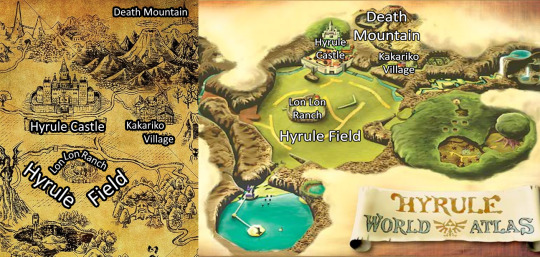

Moving further out, things get a tad stranger however. Let's start in the southwest and move around the map clockwise from there. In that corner of the map, a rendition of Gerudo Desert can be found.
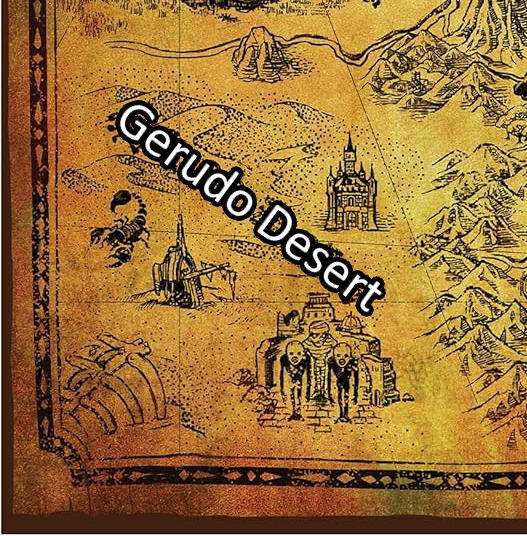
This is consistent with the placement of the desert in top-down Zelda games that were out at the time like A Link to the Past, Four Swords Adventures and A Link Between Worlds. In the 3D games out at the time, the desert instead extended across the entire western portion of the map (Skyward Sword) or the northwest (Ocarina of Time, Twilight Princess).
As for the landmarks on this portion of the map, they are a strange mix. The broken down ship mast may be a reference to the Sandship from Skyward Sword, which was broken after that dungeon is finished. The structure to the bottom of the map appears to be a reference to the Ancient Castle of Ikana from Majora's Mask, given the similarity and the presence of Redeads and a Gibdo (enemies that can be found in and near the castle). This is strange given that the Castle of Ikana is not located in Hyrule, but in Termina, which is a parallel world. The third structure on the top right appears to be an original of the map, but vaguely resembles Hyrule Castle from Twilight Princess. There is also a fourth structure tucked in the mountains on the northeastern border of the desert, perhaps referencing Gerudo’s Fortress from Ocarina of Time.

Moving to the northwest, we find Castor Wilds, a swampy area from The Minish Cap that was also located in Hyrule's west. Interesting to note is that Castor Wild is only the region's name in the English version of The Minish Cap. In Japanese, it is called タバンタ秘境 (Tabantha Wilderness), a name that would be reused in Breath of the Wild and Tears of the Kingdom. This may indicate this map was put together in the west instead of Japan or that the original artist took from the localized games for some reason.
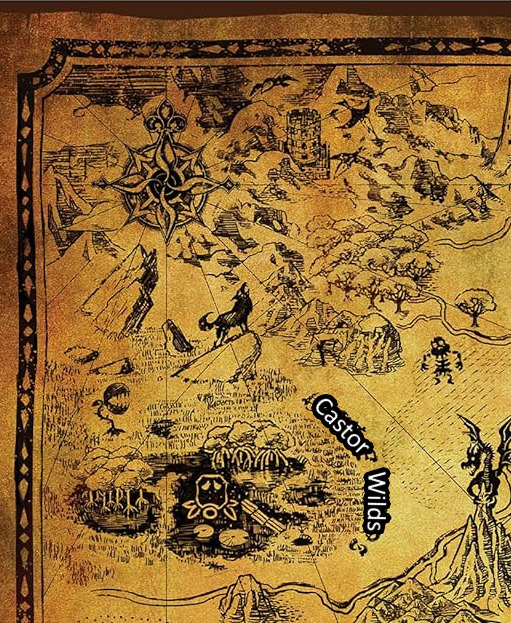
The depiction of Castor Wilds above has more in common with the appearance of the Southern Swamp from Majora's Mask, given the presence of bayou trees, a Big Octo and disconnected bridges made of logs. This poses the same problems as the seeming Ikana Castle in Gerudo Desert, as the Southern Swamp is in a parallel world.

There is also a mountain with a dragon on top in this area, east of Castor Wilds. It brings to mind Dragon Roost Island from The Wind Waker, a tall mountaintop upon which rests the dragon Valoo. That place is found in the northeast of Hyrule however and not the northwest. The dragon on the map also does not particularly look like Valoo, nor does the mountain particularly resemble Dragon Roost Island.
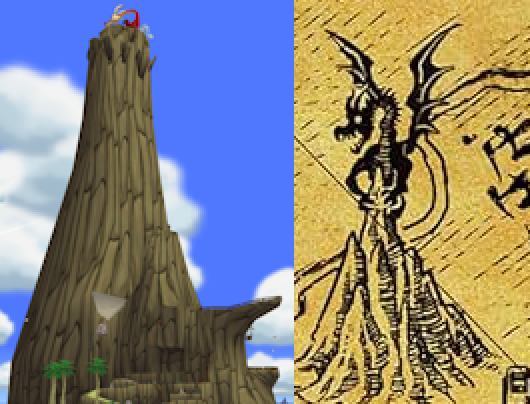
Other than this, there are few notable things in this quadrant. Depictions of a Wolfos, a Deku Baba and Stalchild can be seen, but most of the actual landscape is barren mountains or obscured by the compass. Perhaps the region is supposed to represent Snowpeak, a snowy mountain range in the northwest of Hyrule in Twilight Princess. There appears to be a tower in these mountains surrounded by Guays, but this does not correspond to any known location in the games.
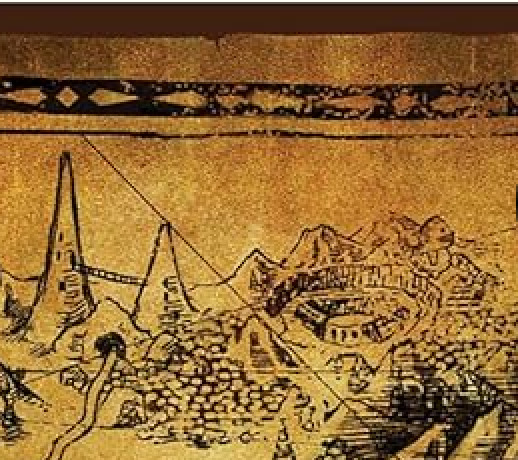
In the direct north of the map are two more structures not in the games: two pointy mountains connected by a rope bridge and a spiral quarry of some kind. A Goron can be seen at this quarry.
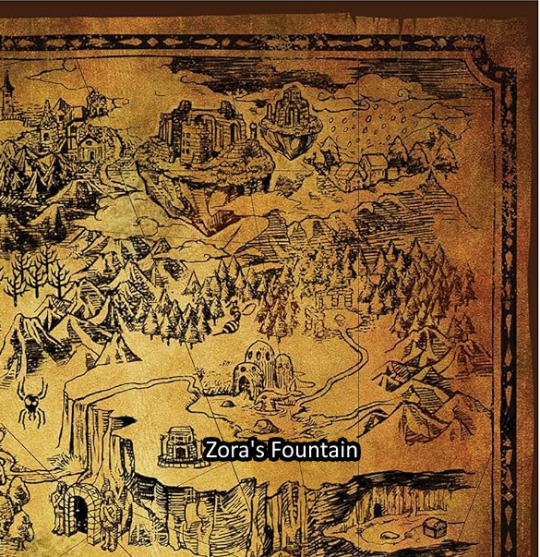
The northwestern quadrant is home to Zora's Fountain, corresponding roughly with its location in Ocarina of Time (south of Death Mountain and Kakariko Village and north of Kokiri Forest). It is far more to the west however, but it is still on top of a mountainous plateau behind a waterfall like in Ocarina of Time. The design of the fountain does not match any depiction found in the games however, albei a Zora can be seen bathing inside it.
Other than this, this quadrant of the map is home to many more structures where it is hard to pin down what they are. There is a village northwest of death mountain, a snowy village in the far northwest of the map and a pond surrounded by ruins that feeds into Zora's Founain. This last structure also somewhat resembles the Fairy Fountains from Ocarina of Time, except that those are found underground. There are also a couple of floating islands, but once again they do not correspond to anything in particular like the City in the Sky or Skyloft.

More to the south of this quadrant we also find a small stone building, a gate guarded by two statues with crossed arms and a cave with a treasure chest. This last structure is likely a reference to grottos from throughout the series wherein treasures can often be found. Finally, a Skulltula is depicted in this quadrant of the map.

The final quadrant of the map, the southeast, is mostly made up of featureless ocean. There is a nondescript ship in that ocean, also what appears to be Gyorg, a boss from Majora's Mask. Other enemies we can find on land here are a Chuchu as first depicted in The Wind Waker and a Peahat. A Gossip Stone is also present in the northeast of the image.
The final names location on the map is Faron Woods, and the art seems to pull from Skyward Sword and Twilight Princess. There is the Great Tree from Skyward Sword's version of Faron Woods and buildings that resemlbe Ordon Village, which is found in the forests south of Faron in Twilight Princess. The general location of Faron Woods on this map also matches that of Ordon, being found in the far south of Hyrule, beyond lake Hylia and many of the woods.

Finally, in this quadrant there are two more nondescript villages that do not correspond to the games.
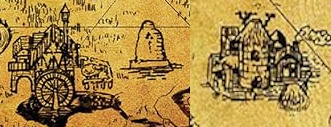
And that is everything I could find on this map. I seems to depict Ocarina of Time Hyrule, with its borders expanded with miscellaneous locations from other 3D Zelda games that were out in 2015. A lot of original locations are also mixed in. The origins of the map still remain a bit vague, but given how much it pops up in Zelda merch, it does appear to be official in some capacity. If anyone has more information about this topic, I'd be happy to know.
Addendum: As pointed out by @lady-sophie-17, it seems the structure at the north of the map with the Goron is actually Goron City, as it appears more or less he same as it is depicted as on the map of Ocarina of Time.

23 notes
·
View notes
Text
Orsan's Metroid timeline
Reposting this from my old account, with updates to reflect Metroid Prime 4: Beyond news.
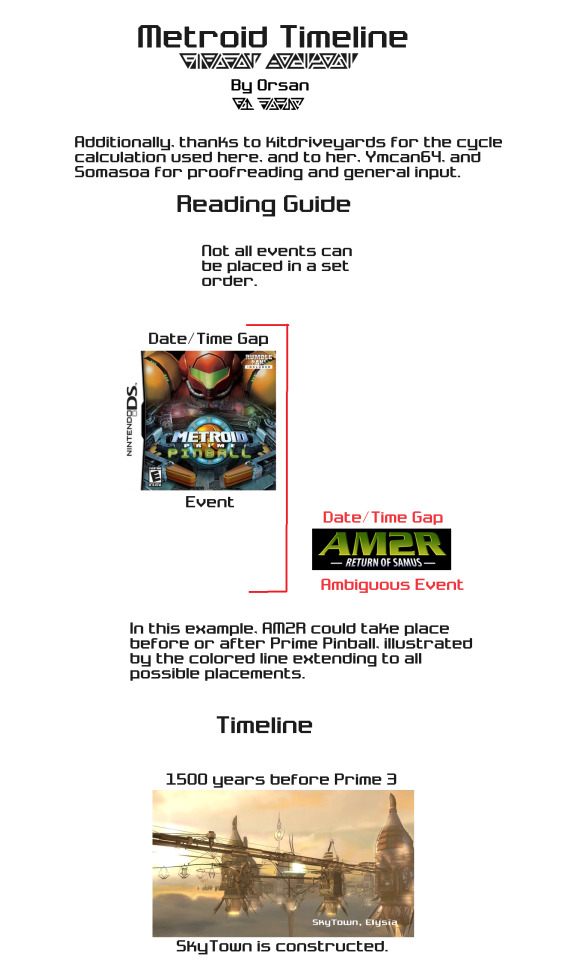





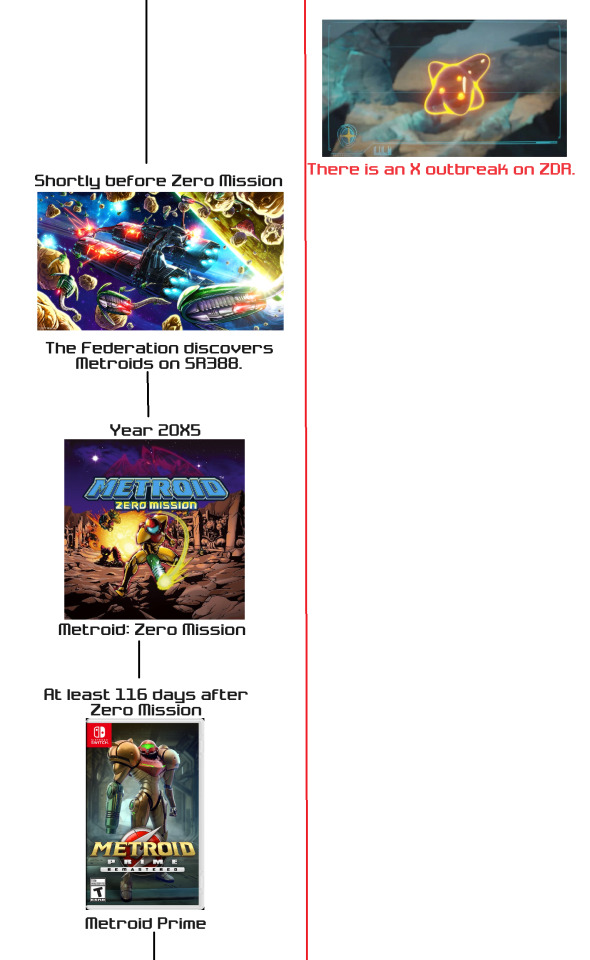



I've aimed to make as few assumptions as possible. Everything here should be reflective of canon information in as much detail as we know. (Although, admittedly, perhaps too many significant figures on the gaps between ZM/Prime 1/Prime 2 and Prime 3/Fed Force.) (If you want to know what order I think events go in, just read top-to-bottom, ignoring the ambiguity lines)
If you have any questions, critiques, or just want to talk, I'm always open to asks or comments asking me about any of my posts! I'm trying to post more lore stuff these days to have publicly available sources for various compilations and deep dives I've done.
Some sources:
Cycle calculation. I used this in conjunction with the logs from Primes 1 and 2 talking about the fall of Zebes to calculate the time gaps between those two games and ZM.
Zebes being settled only after SR388 was massacred comes from this interview with Sakamoto.
Samus's age at various points comes from Other M concept art for both Samus as a child and in the army, in addition to the same interview linked above.
Thanks so much for reading!
20 notes
·
View notes